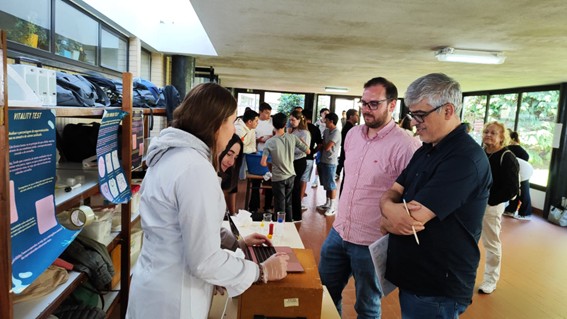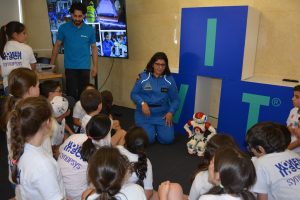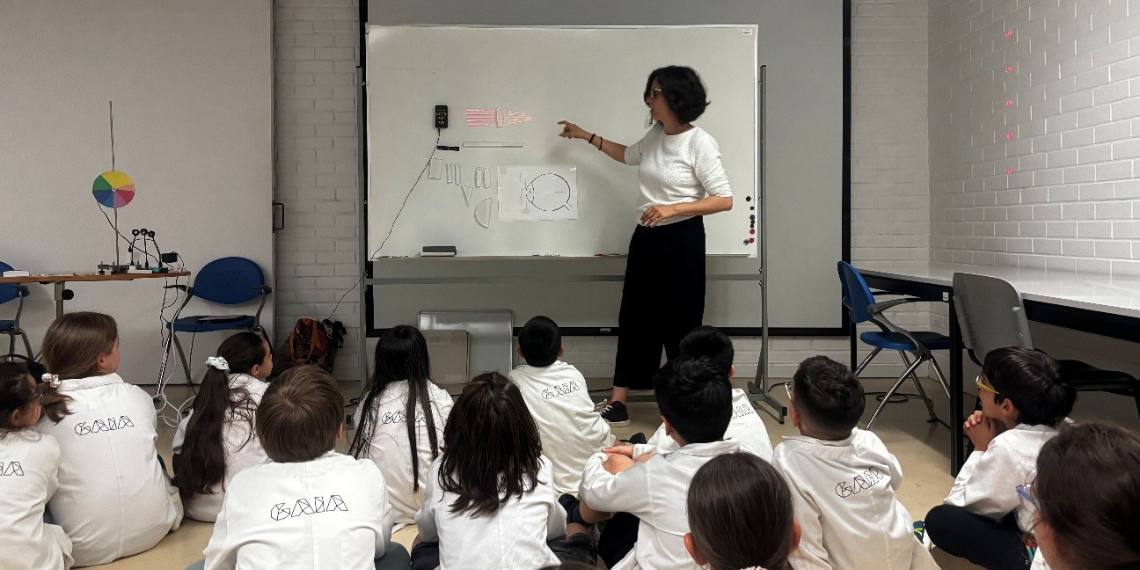Over four initiatives held across three cities, researchers from INESC TEC came together with a shared mission: to introduce young people to the fascinating world of science and technology and to inspire them to explore these fields. In total, more than 2,000 young students had the opportunity to engage with science and technology through Portugal’s largest engineering research institute.
“We’re planting seeds and the idea that science is within everyone’s reach,” said Diana Guimarães, researcher at INESC TEC, describing the institution’s recent involvement in multiple science communication activities aimed at younger audiences. A self-declared enthusiast of these initiatives – which she considers “absolutely crucial to developing not only hard skills but also soft skills” – Diana perceives these moments as a vital bridge between research centres and society.
At one such initiative – Encontro com Cientistas, organised by the Escola Ciência Viva Gaia project – she witnessed firsthand the wonder in young children’s eyes as UV light made certain minerals in a rock glow. Applauses and delighted gasps followed immediately. “You could see their ‘mental gears turning’ as we introduced them to new knowledge,” she recalled.
But Diana also believes these activities go far beyond teaching science. “They create environments where children feel valued, where making mistakes isn’t a problem, and where asking questions is understood as a sign of intelligence. In these moments, children are practising key skills for the world that awaits them: active listening, resilience, empathy, and critical thinking.”
Held at the Parque Biológico de Gaia, the initiative was part of a partnership between Agência Nacional Ciência Viva and Gaia City Council, and followed the STREAM educational model (Science, Technology, Robotics, Engineering, Arts, and Mathematics), targeting primary school students.
Adapting her research for younger audiences poses no challenge, Diana assured. The key, she said – as a researcher in Applied Photonics – is “to explain without overcomplicating, and in an engaging way.” “It’s important to give plenty of practical examples, build empathy, and offer something they can relate to,” she stated.
Hands-on Science Fair
At the 14th edition of the Hands-on Science Fair, Diana Guimarães – along with INESC TEC researchers Susana Silva, João Mendes, Luís Coelho, and Orlando Frazão – had the chance to assess various experiments developed by middle and high school students. According to Diana, the Fair showcased a wide range of skills, from applying the scientific method (observation, hypothesis formulation, experimentation) to effectively communicating scientific ideas in creative and accessible ways.
Projects presented at Colégio do Minho in Viana do Castelo explored fundamental principles in physics, chemistry, engineering, and even physiology. As such, Diana believes that the fair – promoted by the Hands-on Science Network (HSCI) and the Portuguese Society for Optics and Photonics – was as an ideal platform for young people to bring their ideas and interests to life. “These initiatives provide students with a tangible goal, a sense of purpose and recognition, and that’s why they’re so important.”

F1 in Schools
Beyond engaging young people in science and technology, some of Diana Guimarães’ work also aims to boost the involvement of girls in these areas – often male-dominated. A collaboration between INESC TEC and Colégio Horizonte has already led to talks, internships, hands-on demonstrations at the school, and visits to INESC TEC facilities. It also supported the participation of two all-girl teams in the F1 in Schools competition – an international programme that promotes STEM (Science, Technology, Engineering and Mathematics) engagement.
INESC TEC supported the teams by 3D-printing essential prototype parts – including wheels, wings, and helmets – using equipment from the Applied Photonics area, with contributions from researcher Luís Coelho. This made it possible to “bring ideas to life with high quality and technical precision.”
Participation in the competition gave the girls hands-on experience with aerodynamics, 3D printing, 3D design, friction, material resistance, and technical drawing – something Diana sees as “an important step in breaking down barriers and stereotypes.” “Watching a 100% female team compete and innovate in fields traditionally dominated by men sends a powerful message to the whole community – especially younger girls – that gender doesn’t determine talent or passion.”
The F1 in Schools challenge involves teams of 3 to 6 students designing, building, and testing miniature Formula 1 car models. The regional stage, held at the Maceda airbase, saw the two INESC TEC-sponsored teams place 2nd and 3rd out of 15 teams. These results secured them a place in the national finals, where they ranked 11th and 16th – bringing their journey to a close.
Women in Tech
Diana Guimarães also recently participated in the Women in Tech initiative, joining the panel “Empowering Humanity: Inclusive Technology for a Sustainable Future” for an interactive talk titled “People and Skills for the Digital World.” The conversation focused on the growing importance of soft skills in preparing for careers that may not yet exist and technologies that are constantly evolving. This context underscores the need to “nurture critical, adaptable, and emotionally resilient minds.”
On a panel composed exclusively of women, participants also addressed the challenges of gender stereotypes that are present from early childhood. “Girls often don’t see themselves represented in these fields and aren’t encouraged as much as boys. It’s essential to normalise – from a young age – that girls and boys alike can be engineers, programmers, or scientists.”
According to Diana, “significant progress has been made,” such as greater visibility of women in leadership roles and increasing awareness of the need for more inclusive work environments. “But there’s still a long way to go,” she acknowledged.
The Women in Tech Portugal event also featured activities beyond panel discussions – including a special appearance by well-known scientist-astronaut Ana Pires, whose work has inspired many young minds. Over 1,300 children gathered in Porto’s Palácio de Cristal gardens for a day of hands-on activities exploring electronics, guided by researchers. The event offered not only opportunities to learn but also to form meaningful role models and spark curiosity in new areas.
According to Ana Pires, “it’s in these moments of sharing that a passion for engineering is born.” “Showing that doing science can be fun – and that it can take us to incredible places – is what captivates children,” added the INESC TEC researcher.
Ana Alves, co-leader of Women in Tech Portugal, emphasised the importance of the ongoing two-year partnership with INESC TEC: “Together, through Women in Tech Kids, we’re planting seeds of knowledge and inspiring hundreds of children, showing from an early age that technology is a space for everyone. That’s how we turn purpose into real impact: through action, sharing, and a commitment to gender equity in STEM.”

Iniciativa Missão Zero
Ana Pires has had a busy schedule in recent weeks. In addition to her involvement with Women in Tech Portugal, she also took part in an initiative promoted by the European Space Agency (ESA) and the Raspberry Pi Foundation, in collaboration with TAGUSVALLEY. Students from the 7th grade at the Agrupamento de Escolas Abrantes took part in the Iniciativa Missão Zero, where Ana once again answered the call.
This project aimed to promote scientific and technological curiosity among young students, offering them direct contact with advanced technologies and researchers from various fields and backgrounds.
The researchers mentioned in this news piece are associated with INESC TEC, the Faculty of Sciences of the University of Porto and IPP-ISEP.



 News, current topics, curiosities and so much more about INESC TEC and its community!
News, current topics, curiosities and so much more about INESC TEC and its community!